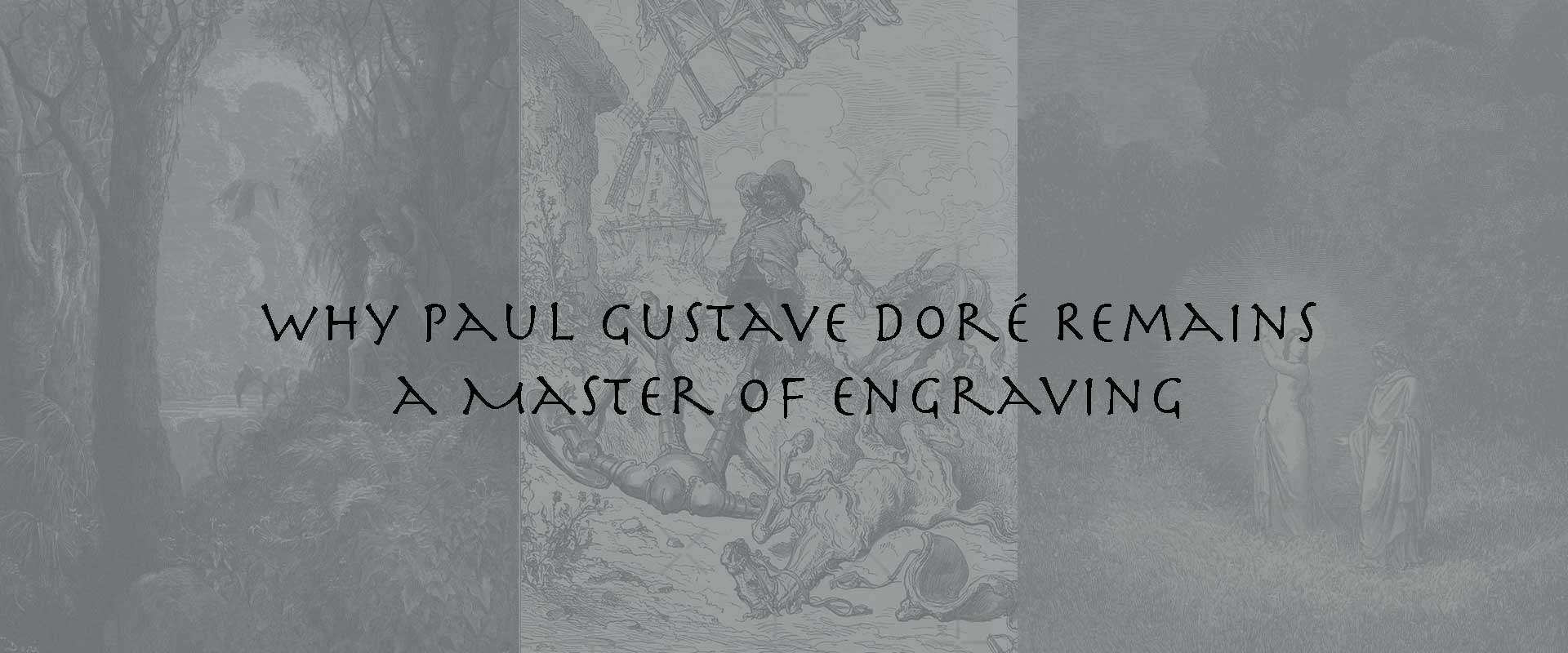Paul Gustave Doré’s legacy stands at the intersection of artistic brilliance and timeless storytelling. In the 19th century, when engraving was the primary medium for visualizing literature and sacred texts, Doré transformed it into something extraordinary. His work was not just a reproduction of words—it was a visual symphony of light, shadow, and symbolism that brought characters and cosmic landscapes to life. Readers of Dante’s Divine Comedy or Milton’s Paradise Lost did not merely imagine the scenes; they saw them through Doré’s dramatic lens. His engravings of the Bible became so influential that they shaped cultural memory itself, embedding certain images of heaven, hell, and divine justice into the global imagination.
What sets Doré apart is the way he combined technical mastery with emotional depth. Every line carried meaning, whether depicting the despair of Job, the tragic grandeur of Satan, or the fragile determination of Don Quixote. His engravings were filled with symbolism that transcended the page, turning literature into experiences of awe, terror, and reflection. Even today, Doré remains one of the few artists whose engravings are not seen merely as illustrations but as independent works of art. This enduring power explains why his creations continue to inspire collectors, artists, and admirers of Paul Gustave Doré art prints, proving that engraving in his hands became not just a craft but a form of eternal storytelling.
Doré’s Unmatched Place in the Art of Engraving
Paul Gustave Doré’s name has become synonymous with the art of engraving. Though the 19th century produced many skilled illustrators, Doré stands out because his work went beyond craft. His engravings were visions of literature, faith, and human struggle, elevating simple text into timeless images.
From biblical illustrations to Dante’s Divine Comedy and Milton’s Paradise Lost, Doré transformed epic stories into engravings that continue to define how readers imagine these works. His enduring influence makes him a true master of engraving, and one whose art remains deeply valued today in collections such as Paul Gustave Doré art prints.
The Craft of Engraving in Doré’s Time
What Made Engraving So Important
Before the age of photography, engraving was the primary way to bring images to mass audiences. Doré’s engravings could be printed widely, making his interpretations available to households across Europe and beyond. His skill ensured that art was not confined to elite galleries but could be experienced by ordinary readers.
- Mass communication of art: Engravings spread images quickly and affordably.
- Faithful detail: Every line held meaning, from light rays to shadows of despair.
- Cultural memory: Engravings became the way people remembered great stories.
Doré’s Mastery of Technique
Doré’s engravings were remarkable for their precision, scale, and atmosphere. His manipulation of line allowed him to capture softness, sharpness, and dramatic contrasts all in the same piece. Few engravers could balance such delicacy with grandeur.
Symbolism and Storytelling in Doré’s Engravings
The Power of Light and Shadow
Doré used light and darkness as symbolic tools. He bathed angels in radiant clarity, cast sinners in harsh shadows, and used beams of light to signify divine intervention. These visual contrasts gave his engravings emotional and spiritual power, much like Bible verse wall art prints continue to use scripture and design together to inspire reflection.
Scale and the Sublime
One hallmark of Doré’s mastery was his manipulation of scale. He often portrayed tiny human figures overwhelmed by vast cosmic landscapes. This not only created awe but also conveyed the Romantic idea of the sublime—the tension between beauty and terror.
Emotion in Line and Gesture
Unlike many illustrators who kept faces simple, Doré carved deep emotion into every expression. His Job weeps with despair, his Quixote gazes with longing, his demons sneer with menace. This ability to capture psychological depth in engraved lines was what elevated Doré above his peers.
Doré’s Engravings of the Bible
One of the reasons Doré is remembered as a master is his Bible series. These engravings remain some of the most influential religious images ever produced. They were more than illustrations—they were visual sermons, teaching faith through symbolic imagery.
Clouds breaking with light, towering angels, or desperate mortals in shadowed landscapes—every engraving was filled with meaning. These works continue to resonate with those who appreciate spiritual wall art, where faith and imagery merge into everyday inspiration.
Dante, Milton, and Cervantes Through Doré’s Eyes
Dante’s Divine Comedy
Doré’s engravings of Dante defined how generations imagine heaven and hell. His scenes of Inferno, with grotesque demons and endless torment, captured the horror of sin. His visions of Paradise, filled with radiant light, revealed divine perfection.
Milton’s Paradise Lost
In Milton’s Paradise Lost, Doré visualized cosmic rebellion. His Satan—muscular, defiant, yet doomed—remains one of the most iconic depictions of the character in art history. His angels, by contrast, glow with unity and grace, symbolizing divine order.
Cervantes’ Don Quixote
Doré also captured the tragic comedy of Don Quixote. The knight’s battle against windmills was drawn with grandeur, turning satire into allegory. His engravings highlighted both the humor and the pathos of Cervantes’ masterpiece, showing how human dreams often collide with reality.
Why Doré Is a Master of Engraving
- Technical precision – unmatched detail and clarity in linework.
- Symbolism – light, darkness, scale, and gesture used as storytelling tools.
- Emotional depth – expressions that captured psychology, not just appearance.
- Universal appeal – engravings accessible to the masses, shaping cultural imagination.
- Enduring influence – his style defined the visual language of classic literature.
Doré’s Enduring Legacy
Doré remains central not only to art history but also to spiritual and cultural imagination. His engravings are still collected, studied, and displayed. They shaped how we visualize scripture, myth, and classic literature. Even modern interpretations, such as Paul Gustave Doré’s dramatic Bible illustrations, show how his art continues to inspire awe and reflection.
In an age of digital media, Doré’s engravings remind us of the enduring power of craftsmanship and vision.
FAQs on Why Paul Gustave Doré Remains a Master of Engraving
What makes Gustave Doré a master engraver?
Doré combined technical precision with symbolic storytelling. His engravings were not just pictures but visual interpretations of literature and faith, filled with light, shadow, and emotional depth.
How did Doré’s Bible illustrations change religious art?
They became the most widely recognized biblical images of the 19th century. Doré gave spiritual texts Romantic visual grandeur, shaping how people imagined scenes from scripture.
Did Doré influence modern art and media?
Yes. His dramatic contrasts influenced early cinema, fantasy illustration, and even modern comics. His visions of hell, angels, and cosmic drama continue to inspire artists today.
How do Doré’s works connect to Romanticism?
Doré’s engravings reflected Romantic ideals of the sublime, awe, and spiritual struggle. He used vast landscapes and contrasts of light and shadow to show humanity’s fragility before eternity.
Where can I find Doré’s engravings today?
His works are preserved in museums and libraries, but they also remain accessible through curated collections such as Paul Gustave Doré art prints, which bring his legacy into homes and personal spaces.





